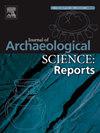GPR survey at the Etruscan necropolis of Sasso Pinzuto, Tuscania (Central Italy)
IF 1.5
2区 历史学
0 ARCHAEOLOGY
引用次数: 0
Abstract
Etruscan cemeteries are the best-known source for the Etruscan civilization and provide valuable insights into their culture shedding light on their funerary customs, social structure, and religious beliefs. We present a geophysical study conducted at the Etruscan necropolis of Sasso Pinzuto, Tuscania (Central Italy), using Ground Penetrating Radar (GPR) to investigate the presence of submerged anthropogenic structures within the area. Our GPR investigations were performed using a 400 MHz antenna in two areas near a site where burial mounds were previously studied. The analysis of acquired data showed both high-amplitude reflections and reflection-free areas with geometric (linear and circular) shapes. In the first area, we detected small circular reflection-free areas, at ∼ 0.40 m depth that are located over five small holes. In the second area, our survey highlighted the presence of reflection-free areas surrounded by sets of high-amplitude reflections between 0.30 m and 1.08 m deep, associated with a circular shaped cavity in the tuff rock. By confirming the existence and location of anthropic structures in the two investigated areas, archaeologists may gain a deeper understanding of the layout of the necropolis and plan subsequent targeted interventions.
意大利中部托斯卡纳萨索平祖托伊特鲁里亚墓地的 GPR 勘测
伊特鲁里亚墓地是伊特鲁里亚文明最著名的资料来源,为了解伊特鲁里亚文化提供了宝贵的资料,揭示了他们的丧葬习俗、社会结构和宗教信仰。我们介绍了在托斯卡纳(意大利中部)萨索平祖托伊特鲁里亚墓地进行的地球物理研究,该研究使用地面穿透雷达 (GPR) 来调查该地区是否存在淹没的人为结构。我们使用 400 兆赫天线在先前研究过坟丘的遗址附近的两个区域进行了 GPR 勘测。对获取数据的分析表明,既有高振幅反射,也有几何形状(线形和圆形)的无反射区域。在第一个区域,我们探测到了深度为 0.40 米的小圆形无反射区域,位于五个小洞之上。在第二个区域,我们的勘测突出显示了 0.30 米至 1.08 米深的无反射区域,其周围是一组高振幅反射,与凝灰岩中的圆形空洞有关。通过确认这两个调查区域是否存在人类结构及其位置,考古学家可以更深入地了解尸城的布局,并制定有针对性的后续干预计划。
本文章由计算机程序翻译,如有差异,请以英文原文为准。
求助全文
约1分钟内获得全文
求助全文
来源期刊

Journal of Archaeological Science-Reports
ARCHAEOLOGY-
CiteScore
3.10
自引率
12.50%
发文量
405
期刊介绍:
Journal of Archaeological Science: Reports is aimed at archaeologists and scientists engaged with the application of scientific techniques and methodologies to all areas of archaeology. The journal focuses on the results of the application of scientific methods to archaeological problems and debates. It will provide a forum for reviews and scientific debate of issues in scientific archaeology and their impact in the wider subject. Journal of Archaeological Science: Reports will publish papers of excellent archaeological science, with regional or wider interest. This will include case studies, reviews and short papers where an established scientific technique sheds light on archaeological questions and debates.
 求助内容:
求助内容: 应助结果提醒方式:
应助结果提醒方式:


